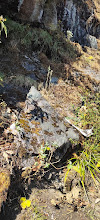 |
| P.C. Heritage Village (Facebook Page) |
The
wondrous Shakshing Lhakhang (monastery) churns gruesome folklores with mystical
tales. The place had its initial name as Samdrup Choling located on
paradisiacal valley above Tsenkharla in Trashi Yangtse. The Lhakhang is now
accessible by a farm road from Tsenkharla and it takes approximately about one
hour to reach the site. The temple owes its existence to Ani (nun) Chorten
Zangmo, the great granddaughter of 15th century Terton (treasure
discoverer) Pema Lingpa.
Ani Chorten Zangmo had three residential places viz. Toe (upper) Lhari in Tibet, Bar (middle) Kisa Gomai in Bumthang and Wog (lower) Shakshing in eastern Bhutan. According to the source, she eloped from Tamshing in Bumthang to escape the matrimonial pressure from Choekhor Deb Kuenthub. Before trooping towards her destined place, her grandfather handed over a precious white conch with the advice to blow it to decide her settlement and flourish Peling tradition. She marched towards east crossing Aja (Place with 100 Tibetan letter A), Balam and finally reached at a peak. Upon blowing the conch, it produced soothing sound at a specific peak and later named the peak as Drametse (a peak without enemies). She decided to settle there and built a small monastery with support from local people. Later, she spent her life into diligent meditative practices and spiritual activities. After residing certain years at Drametse, ani Chorten Zangmo visited her two residents and then came back to at present Shakshing in Trashi Yangtse. Her visit to Shakshing was of paramount blessing for she vanquished evil spirits and subsequently built a small temple which was then named as Samdrup Choling. As no religious figure turned dharma wheel in and around the place except ani Chorten Zangmo. She assumed as head abbot in flourishing Buddhism and blessed the place with many treasures such as oven, holy water, saddle, Guru’s religious hat, foot and hand print, and Buddhist scriptures (Sutra). After having been contributed a lot for the welfare of all sentient beings, at the age of 70, Ani Chorten Zangmo took her final breath and attained nirvana. Her dead body is believed to have taken back and preserved at Drametse. Right after her demise, followers could not give good pastoral care to her properties including temples and nearly fell into complete ruins.
The sacred site remained deserted until lama Ugyen Rangdrol from Kurtoe Nyalam Dung visited Shakshing and he strongly felt the need to restore the monastery. He immediately sought permission from Jangbu Drungpa (Sub-district administrator of Jangphutse) to restore both the ruined temples of Shakshing and Darchen. Shakshing was believed to be head seat for Ani Chorten Zangmo as winter residence and Darchen as summer residence. The move to restore both the temples (Shakshing and Darchen) did not take much time and were brought back to life that eventually helped to flourish Dharma once again. Lama Ugyen Rangdrol named the site as Shaek-zhing, Sheak means ‘arrived’ and Zhing means ‘Buddhahood’. The name is derived as a tribute to Ani Chorten Zangmo and the legacies left before her last breath at Shakshing. Similarly, lama conducted numerous Dharma activities and continued flourishing Buddha dharma throughout nearby places by giving empowerments, religious talk and blessings. The monastery at present day is under the custodian of Koenyer (caretaker) which has been passed down to subsequent heirs and each custodian contributed in upholding the Dharma and maintaining the fame of monastery. The monastery underwent several renovations and successive custodians undertook structural changes over the time. The relics inside the monastery include a statue of Buddha, Guru Rinpoche, Chenrizi (Compassionate Buddha), Dolma (Tara), Tsepamaed (Long life Buddha) and a set of Terton Ratna Lingpa’s vase.

















